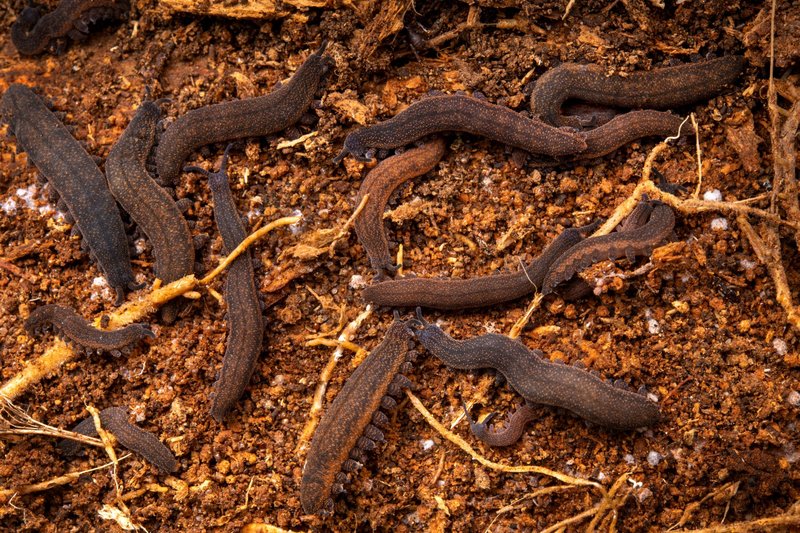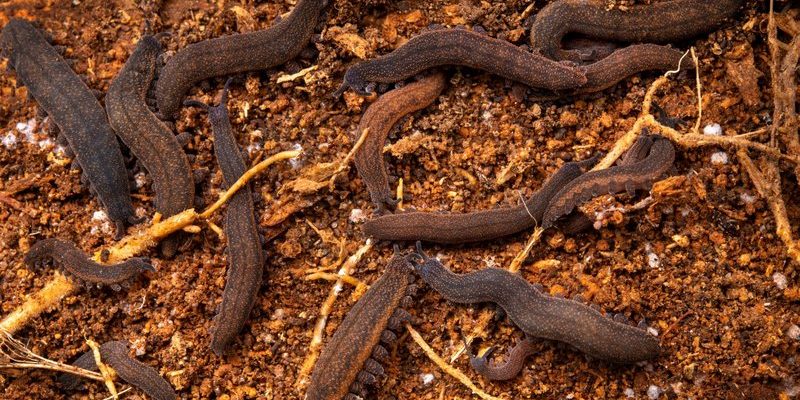
Velvet worms, or *Onychophora*, are not your average garden pests. They thrive in humid, decaying leaf litter and play a crucial role in nutrient cycling. Think of them as nature’s recyclers, breaking down organic materials and keeping the soil rich and fertile. Their unique abilities and interactions with soil environments have made them a hot topic in soil health studies. Let’s dive deeper into why velvet worms matter in our quest for healthier soils and what their presence can tell us about the ecosystem.
What Are Velvet Worms?
Velvet worms might look a bit odd at first glance. Resembling a cross between a caterpillar and a slug, they have soft bodies covered in tiny, hair-like structures called setae. These creatures are not only adorable but also incredibly ancient, dating back to over 500 million years. They can be found in moist environments like leaf litter, under rocks, or in trees, where they thrive in damp conditions.
They hunt for food at night, primarily feasting on insects. With their unique predatory method, velvet worms shoot out a sticky slime to capture their prey, sort of like a mini superhero using web powers. This fascinating hunting strategy also plays an essential role in balancing insect populations in their habitats.
You might be wondering how these peculiar creatures fit into the bigger picture of soil health. Well, their activities contribute to the formation of healthy soil by breaking down organic matter and enhancing nutrient cycles.
The Role of Velvet Worms in Soil Ecosystems
Velvet worms are more than just quirky insects; they are critical players in the health of soil ecosystems. They help decompose organic material by consuming decaying plant and animal matter, returning vital nutrients to the soil. This process is akin to recycling in our daily lives—keeping waste from piling up and ensuring resources are used efficiently.
Studies have shown that areas rich in velvet worms often have better nutrient profiles in the soil. They help facilitate the breakdown of complex organic substances, making nutrients more available for plants and other organisms. In turn, this promotes healthy plant growth, which is essential for sustaining entire ecosystems.
Additionally, velvet worms contribute to soil structure with their burrowing and feeding activities. These worms create channels in the soil, which enhances air and water movement. An optimal soil structure is crucial for promoting healthy root systems and preventing erosion.
Why Are Velvet Worms Important for Soil Health Studies?
Research on velvet worms shines a light on the intricate relationships within soil ecosystems. By studying these creatures, scientists gain valuable insights into the health and functioning of the soil. Since velvet worms are sensitive to environmental changes, their presence or absence can indicate shifts in soil health.
For instance, a decline in velvet worm populations could hint at underlying issues like soil degradation or pollution. This ability to signal changes in the ecosystem makes them useful bioindicators. They tell us that if velvet worms are doing well, it’s likely the soil is also in good shape.
Moreover, understanding their role in nutrient cycling can guide sustainable agricultural practices. Healthy soil not only supports crops but also reduces the need for chemical fertilizers, leading to a more balanced ecosystem.
How Velvet Worms Impact Nutrient Cycling
Nutrient cycling is a vital process that allows ecosystems to thrive. Velvet worms contribute significantly to this cycle by aiding in the decomposition of organic matter. As they digest decaying plants and animals, they break down complex organic compounds into simpler forms that plants can absorb.
Their feeding habits promote microbial activity in the soil, which is crucial for nutrient availability. More microbes mean more breakdown of organic materials, leading to better nutrient cycling. Imagine velvet worms as the little chefs of the soil, transforming raw ingredients into essential nutrients that feed plants and other organisms.
Additionally, velvet worms can help in the formation of humus, a dark organic material in soil that improves soil structure and fertility. This transformation enhances soil health and maintains its ability to support life.
Potential Threats to Velvet Worm Populations
Despite their importance, velvet worms face threats from habitat destruction, climate change, and pollution. Deforestation and urbanization reduce their natural habitats, making it harder for them to thrive. Without suitable environments, their populations may dwindle, disrupting the balance in soil ecosystems.
Climate change also poses a risk, as rising temperatures and shifting rain patterns can alter their habitats. Velvet worms rely on humid environments to survive, and any disruption to these conditions can impact their reproduction and survival rates.
Pollution from agricultural runoff can introduce harmful chemicals into their ecosystems, further threatening their populations. If these creatures decline, it could lead to negative repercussions on soil health and nutrient cycling.
How to Support Velvet Worms in Your Garden
If you’re passionate about soil health and want to support velvet worms in your garden, there are several steps you can take. First, consider creating a habitat that encourages these critters to thrive.
– **Leave Decaying Leaves:** Allow fallen leaves and organic debris to accumulate. This provides food and a cozy home for velvet worms.
– **Avoid Chemical Pesticides:** Using chemical pesticides can harm not just velvet worms but also other beneficial organisms in the soil.
– **Practice No-Till Gardening:** Tilling can disrupt the natural habitat of velvet worms. By minimizing disturbance, you help maintain their environment.
– **Maintain Moisture Levels:** Velvet worms require humid conditions to survive. Ensure your garden has adequate moisture, especially in dry seasons.
By creating a velvet worm-friendly environment, you’re not just helping these wonderful creatures; you’re also promoting a healthy ecosystem that benefits your plants.
Velvet worms may not be the first creatures that come to mind when you think about soil health, but they play an essential role in maintaining the balance of our ecosystems. From aiding in nutrient cycling to enhancing soil structure, these unique animals are critical for sustaining vibrant, healthy soils.
By understanding their importance and the threats they face, we can take steps to protect them in our gardens and natural environments. Supporting velvet worms is like investing in the health of our planet. So, let’s celebrate these little wonders and recognize their hard work in keeping our soils rich and full of life.

